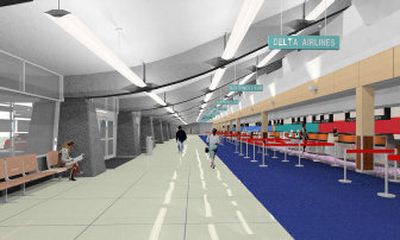Airport has bright ideas for main ticket area

Spokane airport officials will spend $1 million this summer to add some light and sparkle to the main terminal ticket area.
Built in 1965, the main terminal ticket area has had only modest upgrades over the years and is showing its age, said airport spokesman Todd Woodard.
“A key goal is to lighten up the main ticket area and make people more comfortable there,” said Woodard.
The project involves replacing airline ticket counters, widening the vestibule entrances to the terminal, improving lighting and replacing exterior concrete walls with glass and metal walls.
The main terminal, which feeds passengers to the A and B concourses, handles about 60 percent of all Spokane air passengers.
In 2000, the airport spent about $18 million to update and modernize the C Concourse.
Robert Pace, the lead architect working on the main terminal ticket area conversion, said the project will follow the same design approach used in upgrading the C Concourse. Pace works at Bernardo-Wills Architects, the same Spokane firm that designed the C Concourse project.
Woodard said the work will start in mid-summer and should be completed before the Thanksgiving air-traffic rush.
The goal will be do most of the work in the evenings for minimal impact on airlines and passengers, Woodard said.
Funds for the work come from the airport passenger facility charge of $4.50 collected on each departing flier and people making connections through Spokane.
The ticket-area project is unrelated to previously announced plans to change the location of airport security checkpoints in the main terminal rotunda. One goal behind that project is to allow passengers to move through security more quickly and once through, to have more shopping or food choices.
The airport has not yet approved the relocation of the security checkpoints, Woodard said, and no dates for that project have been set.
Pace said a key element in the ticket-area upgrade will be improving the terminal’s “curb appeal” by replacing concrete slab exterior walls with glass and metal “storefront” walls.
Except in a few cases, the current exterior wall of the terminal is solid concrete, creating a dark, isolated interior, he said.
Putting in glass walls along the ticket counter area will “make the airport more transparent” to visitors arriving or leaving, Pace said.
Architecturally, that change will add what’s lacking now, Pace said: a visible connection from outside to inside the airport.
That psychological impact of openness and calm will be enhanced by the addition of new fluorescent ceiling fixtures, which will increase lighting in the ticket area by roughly five times, he said.